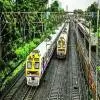
Delhi section of the 82-km 14-lane Delhi-Meerut Green Expressway completed in a record 18 months. Here's more!

Chaitanya Projects to Develop DPR for Chilika Connectivity under Bharatmala
Chaitanya Projects Consultancy, a visionary leader in integrated infrastructure consultancy across India, is developing the Detailed Project Report (DPR) for two signature bridges that will transform connectivity in the Chilika Lake region under the Bharatmala Project. These bridges will provide seamless and sustainable connectivity between Satapada and Janhikuda, addressing long-standing transportation challenges and driving economic and community development in Odisha. Chilika Lake, renowned as the largest coastal lagoon in India, has long grappled with unreliable transportation, impacting..

Shirur MP Requests Relocation of GMRT for Pune-Nashik Rail Project
Shirur MP Amol Kolhe has urged the central government to relocate the Giant Metrewave Radio Telescope (GMRT) near Narayangaon in Pune district to facilitate the proposed Pune-Nashik semi high-speed rail project. In a letter to Union Minister of Science and Technology Dr Jitendra Singh, Kolhe highlighted the developmental challenges posed by the GMRT’s presence, which has led to objections from scientists concerning the railway project. In his letter, dated December 19, Kolhe stated, “The GMRT, established in 1996, is a prestigious scientific installation in my constituency. However, it has..

Indian Railways Expands Its Presence in West Bengal
West Bengal is experiencing a railway revolution as Indian Railways embarks on an ambitious effort to enhance connectivity and infrastructure across the state. With 43 ongoing projects, including new lines, gauge conversions, and track doubling, the state is poised for significant development. On December 20, Railway Minister Ashwini Vaishnaw announced that as of April 1, 2024, 43 projects—comprising 13 new lines, 4 gauge conversions, and 26 track doubling projects—spanning 4,479 km and costing Rs 60,168 crore, will be located fully or partially within West Bengal. Indian Railways has allo..















